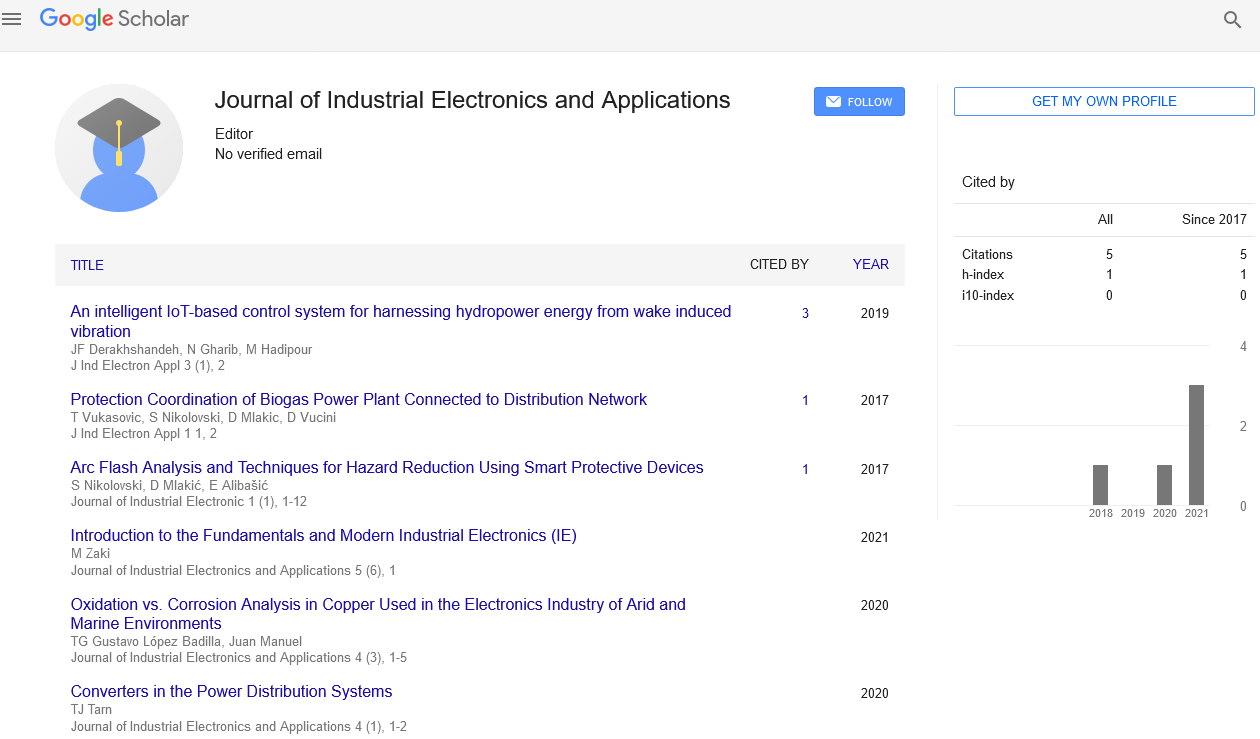Commentary, Vol: 7 Issue: 3
Electrical Machines and Drives: The Significance of Electrical Machines and Drives
Nick Joles*
1Department of Electrical Engineering, Islamic Azad Univerisity, Esfahan, Iran
*Corresponding Author: Nick Joles,
Department of Electrical Engineering,
Islamic Azad Univerisity, Esfahan, Iran
E-mail: nick23joles@gmail.com
Received date: 05 September, 2023, Manuscript No. JIEA-23-117728;
Editor assigned date: 07 September, 2023, PreQC No. JIEA-23-117728 (PQ);
Reviewed date: 21 September, 2023, QC No. JIEA-23-117728;
Revised date: 29 September, 2023, Manuscript No. JIEA-23-117728 (R);
Published date: 06 October, 2023, DOI: 10.36648/JIEA.1000042
Citation: Joles N (2023) Electrical Machines and Drives: The Significance of Electrical Machines and Drives. J Ind Electron Appl 7:3.
Description
Electrical machines and drives are at the heart of our modern world, driving the technological advancements that have shaped our society. These systems are essential components in countless applications, ranging from industrial machinery and transportation to renewable energy generation. The fundamentals of electrical machines and drives, their diverse applications, and their pivotal role in powering the world we live in.
Understanding electrical machines and drives
Electrical machines and drives are a critical part of electrical engineering. They are designed to convert electrical energy into mechanical energy and vice versa and control the motion of machines and systems. These systems operate based on the principles of electromagnetism and electromagnetic induction.
These include motors and generators. Electric motors convert electrical energy into mechanical energy, providing motion to various devices, while generators do the opposite, converting mechanical energy into electrical energy.
Drives are the control systems that regulate the speed, torque, and direction of electric machines. They play a crucial role in optimizing the performance of machines and ensuring energy efficiency.
Applications of electrical machines and drives
Electrical machines and drives are integral to industrial automation. Electric motors drive conveyor belts, robotic arms, and assembly line machinery, optimizing manufacturing processes and enhancing productivity.
Electric machines and drives are fundamental in modern transportation. Electric Vehicles (EVs) rely on electric motors and drives to provide power, making them more energy-efficient and environmentally friendly. Electric trains, trams, and subways are also powered by these systems.
In the field of renewable energy, electrical machines and drives are pivotal. Wind turbines use generators to convert mechanical energy from the wind into electrical power. Solar tracking systems, which adjust the angle of solar panels, use electric drives to maximize energy capture.
Electric machines and drives are used in aircraft for applications such as operating landing gear, controlling flaps and ailerons, and providing power to critical systems.
Everyday household appliances, such as refrigerators, washing machines, and air conditioners, utilize electric machines and drives to deliver the necessary functions efficiently.
The medical field relies on electrical machines and drives for precise control in equipment like MRI machines, surgical robots, and diagnostic devices.
Electrical machines and drives are pivotal in the field of renewable energy. Wind turbines use generators to convert mechanical energy from the wind into electrical power. Solar tracking systems, which adjust the angle of solar panels, use electric drives to maximize energy capture.
The transformative impact
The adoption of electric machines and drives in electric vehicles and renewable energy technologies is contributing to a more sustainable and eco-friendly future.
Industrial automation, driven by electric machines and drives, has led to increased efficiency and productivity, revolutionizing manufacturing processes.
Precise control provided by these systems is a catalyst for advancements in medical equipment and procedures.
Electric machines and drives are pivotal in the ongoing revolution in transportation, with electric vehicles becoming more prevalent and environmentally conscious.
Conclusion
Electrical machines and drives are the unsung heroes of our technological world, powering industries, transportation, and our daily lives. They are at the forefront of the quest for sustainability and efficiency, with a transformative impact on various sectors. The influence of electrical machines and drives on modern society is undeniable. Their impact is felt across numerous domains.Electric drives play a crucial role in optimizing the energy consumption of machines, reducing waste and environmental impact. As these technologies continue to advance, we can anticipate a future where electrical machines and drives play an even more significant role in the creation of a cleaner, more energy-efficient, and interconnected world.
 Spanish
Spanish  Chinese
Chinese  Russian
Russian  German
German  French
French  Japanese
Japanese  Portuguese
Portuguese  Hindi
Hindi 